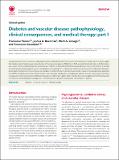Diabetes and vascular disease: pathophysiology, clinical consequences, and medical therapy: part I
Citation
Paneni, Francesco, Joshua A. Beckman, Mark A. Creager, and Francesco Cosentino. 2013. “Diabetes and vascular disease: pathophysiology, clinical consequences, and medical therapy: part I.” European Heart Journal 34 (31): 2436-2443. doi:10.1093/eurheartj/eht149. http://dx.doi.org/10.1093/eurheartj/eht149.Abstract
Hyperglycemia and insulin resistance are key players in the development of atherosclerosis and its complications. A large body of evidence suggest that metabolic abnormalities cause overproduction of reactive oxygen species (ROS). In turn, ROS, via endothelial dysfunction and inflammation, play a major role in precipitating diabetic vascular disease. A better understanding of ROS-generating pathways may provide the basis to develop novel therapeutic strategies against vascular complications in this setting. Part I of this review will focus on the most current advances in the pathophysiological mechanisms of vascular disease: (i) emerging role of endothelium in obesity-induced insulin resistance; (ii) hyperglycemia-dependent microRNAs deregulation and impairment of vascular repair capacities; (iii) alterations of coagulation, platelet reactivity, and microparticle release; (iv) epigenetic-driven transcription of ROS-generating and proinflammatory genes. Taken together these novel insights point to the development of mechanism-based therapeutic strategies as a promising option to prevent cardiovascular complications in diabetes.Other Sources
http://www.ncbi.nlm.nih.gov/pmc/articles/PMC3743069/pdf/Terms of Use
This article is made available under the terms and conditions applicable to Other Posted Material, as set forth at http://nrs.harvard.edu/urn-3:HUL.InstRepos:dash.current.terms-of-use#LAACitable link to this page
http://nrs.harvard.edu/urn-3:HUL.InstRepos:11855831
Collections
- HMS Scholarly Articles [17922]
Contact administrator regarding this item (to report mistakes or request changes)



